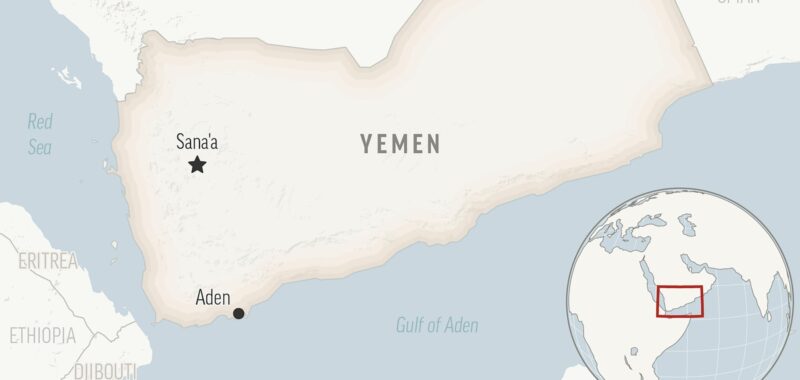DUBAI, United Arab Emirates — U.S. airstrikes targeting the Ras Isa oil port held by Yemen’s Houthi rebels killed 20 people and wounded 50 others, the group said early Friday.
The strikes, confirmed by the U.S. military’s Central Command, represent one of the highest reported death tolls so far in the campaign launched under President Donald Trump that has involved hundreds of strikes since March 15. The Iranian-backed Houthis later Friday launched a missile toward Israel that was intercepted, the Israeli military said, causing sirens to sound in Tel Aviv and other areas.
The war in Yemen meanwhile further internationalized as the U.S. alleged a Chinese satellite company was “directly supporting” Houthi attacks, something Beijing did not immediately acknowledge.
The Houthis’ al-Masirah satellite news channel aired graphic footage of the aftermath of the attack on Ras Isa port, showing corpses strewn across the site. It said paramedic and civilians workers at the port had been killed in the attack, which sparked a massive explosion and fires.
In a statement, Central Command said that “U.S. forces took action to eliminate this source of fuel for the Iran-backed Houthi terrorists and deprive them of illegal revenue that has funded Houthi efforts to terrorize the entire region for over 10 years.”
“This strike was not intended to harm the people of Yemen, who rightly want to throw off the yoke of Houthi subjugation and live peacefully,” it added. It did not acknowledge any casualties and declined to comment when asked by The Associated Press regarding civilians reportedly being killed.
The Ras Isa port, a collection of three oil tanks and refining equipment, sits in Yemen’s Hodeida governorate along the Red Sea. NASA satellites that track forest fires showed an intense blaze early Friday morning at the site just off Kamaran Island, targeted by intense U.S. airstrikes over the last few days.
The Ras Isa port also is the terminus of an oil pipeline stretching to Yemen’s energy-rich Marib governorate, which remains held by allies of Yemen’s exiled government. The Houthis expelled that government from Yemen’s capital, Sanaa, back in 2015. However, oil exports have been halted by the decadelong war and the Houthis have used Ras Isa to bring in oil.
The Houthis denounced the U.S. attack.
“This completely unjustified aggression represents a flagrant violation of Yemen’s sovereignty and independence and a direct targeting of the entire Yemeni people,” the Houthis said in a statement carried by the SABA news agency they control. “It targets a vital civilian facility that has served the Yemeni people for decades.”
On April 9, the U.S. State Department issued a warning about oil shipments to Yemen.
“The United States will not tolerate any country or commercial entity providing support to foreign terrorist organizations, such as the Houthis, including offloading ships and provisioning oil at Houthi-controlled ports,” it said.
The attack follows Israeli airstrikes on the Houthis which previously hit port and oil infrastructure used by the rebels after their attacks on Israel.
Meanwhile, U.S. State Department spokesperson Tammy Bruce in a briefing with journalists accused Chang Guang Satellite Technology Co. Ltd., a commercial satellite image provider, of “directly supporting Iran-backed Houthi terrorist attacks on U.S. interests.”
Bruce did not elaborate in detail, but acknowledged a story by The Financial Times that quoted anonymous American officials saying the firm linked to the People’s Liberation Army has provided images allowing the rebels to target U.S. warships and commercial vessels traveling through the Red Sea corridor.
“Beijing’s support, by the way, of that company, the satellite company, even after we’ve engaged in discussions with them about this … certainly contradicts their claims of being peace supporters,” Bruce said.
Chinese officials and the company, known by the acronym CGSTL, could not be immediately reached for comment. Chinese state media did not acknowledge the accusation. The U.S. Treasury sanctioned CGSTL in 2023 for allegedly providing satellite images to the Russian mercenary force the Wagner Group as it fought in Ukraine as part of Russia’s full-scale invasion.
An AP review has found the new U.S. operation against the Houthis under President Donald Trump appears more extensive than that under former President Joe Biden, as Washington moves from solely targeting launch sites to firing at ranking personnel and dropping bombs on cities.
The new campaign of airstrikes started after the rebels threatened to begin targeting “Israeli” ships again over Israel blocking aid entering the Gaza Strip. The rebels have loosely defined what constitutes an Israeli ship, meaning many vessels could be targeted.
The Houthis targeted more than 100 merchant vessels with missiles and drones, sinking two of them and killing four sailors from November 2023 until January of this year. That has greatly reduced the flow of trade through the Red Sea corridor, which typically sees $1 trillion of goods move through it. The Houthis also launched attacks targeting American warships without success.
The U.S. campaign shows no signs of stopping, as the Trump administration has also linked its airstrikes on the Houthis to an effort to pressure Iran over its rapidly advancing nuclear program. A second round of negotiations between Iran and the U.S. is due to happen Saturday in Rome.
___
Associated Press writer Sam Mednick in Tel Aviv, Israel, contributed to this report.

